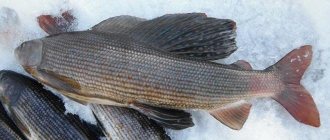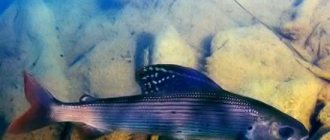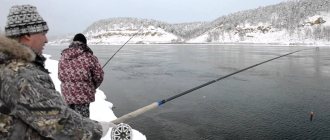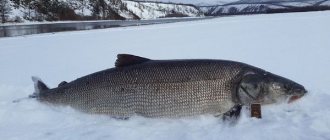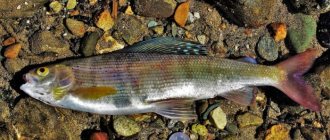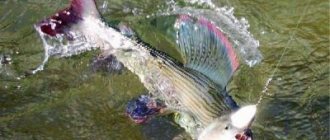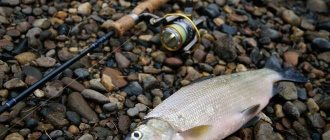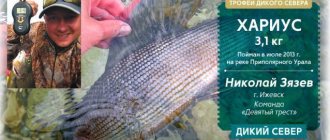Grayling is a medium-sized fish from the salmon family. A characteristic feature of the grayling is its large dorsal fin, which, when folded, reaches the adipose fin and sometimes even the base of the caudal fin. Fishermen compare the dorsal fin of grayling to a sail. Grayling is one of the popular fish among anglers who fish with fly, spinning, or float rods. Grayling meat is considered dietary, due to its high protein content and low fat content, it has a delicate taste and aroma. Let's tell you more about this fish.
Appearance
Grayling body
Grayling has an elongated, streamlined and strong body, which allows it to move in water at high speed, including against strong currents. The body is covered with large scales that fit tightly to the body. The shiny scales of grayling vary in color, some with a greenish or bluish tint. The grayling's back is dark gray in color, with black spots on the sides.
The main distinguishing feature of the grayling is its large dorsal fin. When folded, the dorsal fin of the grayling reaches the caudal fin. Anglers, due to its large size, compare it to a flag, sail or fan. The dorsal fin of grayling can be used to distinguish males from females. The female grayling has a fin of the same height along its entire length, or even becomes slightly lower towards the tail. In male grayling, the dorsal fin increases in height closer to the tail. On the dorsal fin of grayling there are reddish spots and vertical stripes of turquoise or purple shades.
Between the dorsal and caudal fins there is a small adipose fin, which indicates the salmon origin of the grayling.
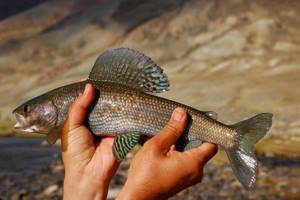
The anal and caudal fins are reddish-burgundy. On the caudal fin there are spots of different sizes, having a reddish color and dark stripes with a lilac or bluish tint. As a rule, European grayling are paler and less spotted than representatives of other species.
The head of the grayling is quite narrow, with large bulging eyes located on it. The grayling's mouth is not too large, the upper one. The mouth contains brush-shaped teeth.
Body coloring
Grayling is deservedly considered one of the most beautiful freshwater fish living in our country. The coloring of grayling gives it the opportunity to survive in difficult conditions, carefully camouflaging it from enemies.
Grayling has a uniform dark gray back, along which small black spots of various shapes are scattered, which also extend onto the dorsal fin. The grayling's body color combines a combination of stripes and spots from bright colors to very dark, almost black. These spots and stripes can make grayling appear greenish, blue, brown or lilac. The sides of the grayling are light silver, the belly is grayish. Graylings with yellow bellies are sometimes found.
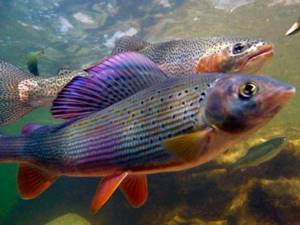
The Siberian grayling and its subspecies have a large reddish spot above the pelvic fins, and on the ventral fins themselves there are red-brown stripes with a purple tint. The caudal and anal fins are reddish-burgundy.
The color of grayling is determined not only by its genes and the conditions in which it lives. Graylings living in large rivers have a lighter color, and those living in small rivers are darker.
During the spawning period, the color of grayling becomes even brighter and more attractive; young graylings acquire a juvenile coloration, with transverse dark stripes.
Age and size of grayling
The maximum size of grayling depends on the species; the largest among graylings is considered to be European grayling, it reaches a size of up to 40-50 cm, some individuals up to 60 cm. The weight of such grayling can reach 5-6 kg, but more often up to 3-4 kg. Mongolian grayling also reaches large sizes; the weight of the largest specimens can reach up to 5-6 kg.
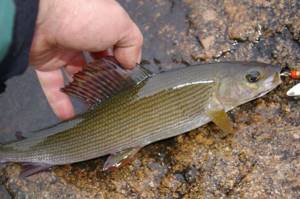
The growth rate of grayling depends on the richness of the food supply, water temperature, light conditions, and oxygen saturation of the water. If the living conditions of the grayling are favorable, then by the age of 7-8 years it reaches a weight of 2.5 kg, but if the conditions leave much to be desired, the weight of a 7-8-year-old grayling will not exceed 500-700 grams. Grayling, 25-35 cm long and most often weighing no more than 1-1.5 kg, predominates in fishermen's catches.
The most favorable conditions for the life of grayling are found in large rivers in a temperate climate; grayling of maximum size is found in such places. In water bodies at higher latitudes, the living conditions for grayling are not so favorable, and here they reach significantly smaller maximum sizes. In Siberian mountain lakes, dwarf-sized graylings are found; until the end of their lives, they retain bright colors with dark stripes on the sides, like fry.
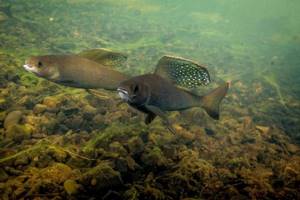
The maximum lifespan of grayling is about 14-15 years, but in nature only a few individuals reach such an advanced age.
Calories and nutritional value
Due to its low calorie content, grayling is included in dietary sports nutrition, weight loss menus, and treatment tables in sanatoriums. Nutritional value of fish:
| Product | Kcal per 100 grams | Proteins per 100 g | Fats per 100 g | Carbohydrates |
| Grayling raw | 112,0 | 20,6 | 3,3 | 0,0 |
| Boiled | 88,0 | 19,1 | 2,7 | 0,0 |
| Smoked | 138,0 | 21,1 | 6,4 | 0,0 |
| Salty | 144,0 | 21,4 | 8,5 | 0,0 |
| Fried | 121,0 | 20,6 | 6,7 | 0,0 |
Grayling recipes
Double grayling fish soup with potatoes
Grayling is a very delicate fish, which is added to the fish soup only at the very end and only for…
View recipe
Lightly salted grayling pieces
If you want to pickle grayling, but you don’t have 2-3 days for this, you can make weak...
View recipe
+ Other grayling recipes
The calorie content and balance of BZHU can change with different methods of culinary processing.
Relatives and species of grayling
Graylings belong to the salmonidae order, the salmon family, which includes the subfamilies grayling, whitefish and salmonids. Thus, the closest relatives of grayling are whitefish and salmon.
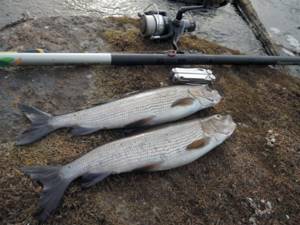
Three main species of grayling and several subspecies and varieties live on the territory of our country.
European grayling

Distributed throughout Europe, from Great Britain to the Urals. On the territory of our country it lives in river basins and lakes in the North of the European part of Russia. It differs from other types of grayling in its brighter coloring and increased size of the dorsal fin. The maximum size of European grayling reaches 50 cm.
Puberty in European grayling occurs earlier than in Siberian grayling. Females begin to lay eggs at two years of age, males become capable of reproduction at the age of 3-4 years.
You may be interested in: Rating of spinning reels
Siberian grayling
It lives in almost all reservoirs of the northern and eastern regions of Siberia; in the southern regions of Siberia it is found in cold lakes and rivers of the foothills. Inhabits Lake Baikal and the rivers of its basin.
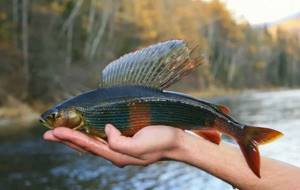
It differs from other types of grayling in its darker color, larger mouth, and wider but shorter dorsal fin. Paired fins of an orange hue, unpaired fins of a deep purple hue. The dorsal fin has large spots with a metallic sheen. Siberian grayling forms several subspecies and varieties.
Siberian graylings living in the northern polar regions grow slowly; at the age of 9-10 years they rarely weigh more than 500 grams. Siberian grayling weighing 1 kg is already considered a trophy by fishermen. In many reservoirs of Siberia, dwarf forms of Siberian grayling weighing no more than 200 grams are found.
Mongolian grayling
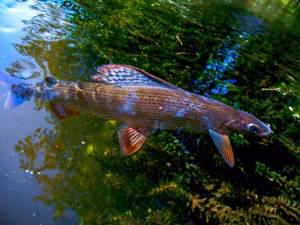
Mongolian grayling is considered one of the largest representatives of the grayling genus. Mongolian grayling lives in the waters of northwestern Mongolia.
Description of grayling
Grayling fishing is an aesthetic pleasure. Due to their relative rarity, graylings are not harvested industrially and cannot be seen on store shelves. In the European part of Russia, they are included in the regional Red Data Books; there is no ban on catching them only in the Asian territory of the country. Fishing is possible in the Ob and Yenisei basins, in the Altai rivers, in the Amur and Kolyma basins. Some species inhabit Lake Baikal and the rivers flowing into it.
Grayling belongs to the salmon species of fish and has an adipose fin at the beginning of the caudal section of the body. In all species, except the Mongolian, the males have a highly developed dorsal fin of almost a train shape. It is believed that its movements contribute to better fertilization of eggs during spawning.
Appearance
The peculiarities of how the fish looks allow us to consider it the most beautiful of the Russian species. The coloring of male graylings becomes especially bright during the mating season. The trailing dorsal fin is dark in color with numerous spots of crimson, blue and violet shades with a metallic tint, and in the Angara subspecies it has a wide crimson border.
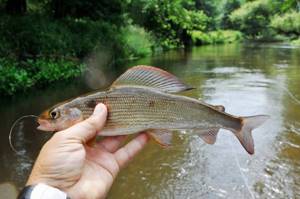
A reddish spot appears on the body, in the area of the anal fin. In the black Baikal subspecies it stands out most brightly, in light-colored varieties it is paler. The breeding plumage is complemented by red stripes on the ventral and caudal fins.
Females are olive or dark in color and are not as beautiful. The young have a protective striped coloration. The scales of the fish are small, tightly fitting, with a beautiful greenish or blue tint; the color of the belly is only slightly lighter than on the back.
The body shape of the river predator resembles salmon. Depending on the species, sizes can range from 50−60 cm in European species to 1 m in Mongolian species. Siberian varieties rarely exceed 50 cm, and even dwarf forms are found (no more than 30 cm in length).
Lifespan
Grayling lives on average 13-15 years. Its lifespan may be slightly shorter or longer, depending on living conditions.
Lifestyle
All representatives of the genus are freshwater fish. They cannot be found in the coastal waters of seas and oceans, where large rivers flow. They lead a relatively sedentary lifestyle, migrate nearby for spawning, and lake forms do not rise into rivers. Spawning migration is caused by the search for better conditions: shallows with a sandy or small-pebble bottom.
Fish overwinter at depth, accumulating in bottom holes. They show a tendency towards the company of their own kind during the mating season, but mostly lead a solitary life. They prefer deep parts of reservoirs with shelters. Young animals often gather in small flocks.
If there is a good food supply, they behave like typical predators, hunting small fish. When there is a lack of such food, they collect benthic inhabitants (worms and invertebrates) and are able to eat the eggs of other species. They often grab insects falling into the water; adult individuals often catch insects in flight, jumping out of the water. It is believed that grayling can grab a small animal (mouse, shrew) swimming across a body of water.
The Siberian and Mongolian varieties have well-developed teeth. The inhabitants of European waters are distinguished by small, almost reduced teeth and smaller mouth sizes.
Spawning
They begin to spawn at 2-3 years of age. Grayling fish spawn in such small places that even part of its back can stick out from the water. The female digs a hole in the ground, where she spawns a portion of large golden eggs. The size of the eggs is up to 4 mm. The male waters the eggs with milk, and the high dorsal fin creates turbulence in the water, preventing the rapid removal of the seminal fluid by the current. After spawning, the parents do not care about the eggs and return to their habitats.
The fry appear on days 5–10 and swim independently on days 3–5. In the first weeks of life they feed on invertebrates and small plankton.
Spreading
Various species of grayling live throughout the northern part of Eurasia, as well as in the northern part of North America.
European grayling is distributed throughout the northern part of Europe from France in the west to the Urals in the east. The European grayling population has declined significantly, and many European rivers where it used to live are no longer present.
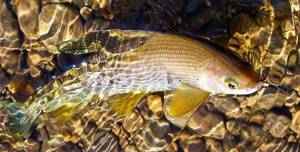
The Mongolian grayling has a limited range, living only in lakes in northern Mongolia, near the Russian border.
The Siberian grayling has the widest range; several of its subspecies inhabit the entire Asian part of Russia, from the Urals, through all of Siberia, right up to the eastern tip of Eurasia. American subspecies of Siberian grayling are found in North America, and large numbers of grayling are found in Canadian water bodies.
Grayling habitats
Grayling loves clean, fast, cool water, saturated with oxygen. It lives in both lowland and mountain rivers, but prefers the latter. May be found in large streams. Graylings are also found in lakes, although much less frequently. Grayling can live in reservoirs at altitudes of up to 2300 meters. It can live in brackish water and is found in the deltas of large Siberian rivers, but stays near the surface where the water is closer to fresh.

Grayling's favorite rivers are rivers with an uneven, winding bed, with many holes and rapids that have a hard rocky or pebble bottom.
Favorite habitats of grayling in water bodies:
- Riffles and rapids with rapid currents are the favorite habitats of grayling; the water here is the coolest and cleanest.
- Graylings stay in deep pools and holes only in winter; it is useless to look for them here in summer.
- In small rivers and streams, graylings stay near the shore; in large rivers they stay away from the shore, swimming up to it only in the morning and evening in search of food.
- Grayling chooses parking spots next to some kind of shelter, which can be trees fallen into the water, snags, stones or vegetation on the river bottom, or tree branches hanging into the water.
- Near the grayling site there must be a clean area of water, a stretch where it will look for prey.
Description of work
The morphological characteristics, pattern on the dorsal fin, some biological indicators and variability of the control region of mitochondrial DNA of graylings from the upper reaches of the river were studied. Kobdo (western Mongolia). The results obtained showed that the grayling of this section of the river is represented by large (predatory) and small (benthivorous) forms of the Mongolian grayling Thymallus brevirostris. The latter form was previously erroneously identified with the Siberian grayling Thymallus arcticus.
However, the genetic unity of large and small forms, homogeneity in meristic characters, similarity in the pattern of variations in the color of the scales and the pattern on the dorsal fin indicate that they belong to the same species. The water bodies of the Central Asian basin are also inhabited by populations of Mongolian grayling with a mixed type of diet and signs of external structure, to varying degrees, characteristic of both forms.
The study of graylings (Thymallidae), as well as other fish of Mongolia, is of great scientific and practical interest. The modern lake-river system of western Mongolia is the remnants of a large freshwater reservoir that existed several million years ago (Hypotheses considering the development of the hydraulic network in Mongolia in the Pliocene-Pleistocene are given in the work of Tugarina and Dashidorzhi (1972).).
According to the assumption of a number of authors (Svetovidov, 1936; Tugarina, Dashidorzhi, 1972; Tugarina, 1981; Makoedov, 1999), it was from here that grayling could have settled in the Pliocene-Pleistocene time.
Until recently, it was believed that the lakes and rivers of the Central Asian basin were inhabited by the Mongolian Thymallus brevirostris Kessl. and Siberian Thymallus arcticus (Pall.) grayling, in the lake. Khubsugol - Kosogol grayling Thymallus arcticus nigrescens Dor. (The taxonomic status of the Kosogol grayling needs clarification (Knizhin, Weiss, 2007; Weiss et al., 2007).), in the upper reaches of the Yenisei and Selenga - the West Siberian grayling Thymallus arcticus arcticus (Pall.), and in Kerulen and Onon - the Amur grayling Thymallus grubii Dyb. (Dulma, 1973; Pivnicka, Hensel, 1978; Shatunovsky, 1983, 1985; Baasanjav et al., 1988; Baasanjav, Tsend-Ayush, 2001; Knizhin et al., 2004).
Kottelat (2006), based on an analysis of previously published works on fishes of Mongolia, in addition to the mentioned taxa, suggests the presence of another species, Thymallus sp. in the river Shishkid Gol (upper reaches of the Yenisei, Darkhat Basin), as well as in lake. Uvs Nur (personal communication). Adjacent to the river. The Kobdo basin of the upper Ob is inhabited by the Upper Ob grayling Thymallus nikolskyi Kasch (the authors consider the species to be the form inhabiting the upper reaches of the Ob River (the Biya, Katun, Chuya rivers), described by Kashchenko (1899)).
The debate about the taxonomic status of the Mongolian grayling Thymallus brevirostris has been ongoing since the mid-19th century. One specimen of this species from an unknown body of water located in the southern Altai region of China is held by the British Museum of Natural History (BMNH no. 1898.2.17.1). It was this individual that was studied by Boulenger (Boulenger, 1898) and served as the basis for the description of Phylogephyra altaica. Benke (1965), who studied this exhibit, identified features that distinguish this form from other representatives of the river. Thymallus, indicates a large head, a long upper jaw, and the number of rays in the ventral fin. The last specimen he studied turned out to have 12, which, in his opinion, is 1-2 more rays than in the known species and subspecies.
The description of Boulenger (Boulenger, 1898) largely coincided with the description of Thymallus brevirostris given by Kessler (1879), and therefore P. altaica was recognized by Berg (1907) as its synonym. However, Benke (1965) and Jordan (1923) and Travers (1989) considered P. altaica a distinct taxon. Svetovidov (1936) allowed the possibility of separating Phylogephyra into a special subgenus of the genus Thymallus.
At the end of the 19th century, through the expedition of Kozlov and Kaznakov, graylings (Nos. 11747, 12644) collected in the river were delivered to the museum of the Zoological Institute of the Russian Academy of Sciences (St. Petersburg). Kobdo (R. Khovd (Mong.).). Berg (1907) attributed some of the individuals from this collection to the Siberian grayling Thymallus arcticus. For a long time, the existence of this species in the water bodies of western Mongolia was not in doubt. Svetovidov (1936), and then Berg (1948) suggested the possible hybridization of the Siberian Thymallus arcticus and the Mongolian Thymallus brevirostris graylings in the river basin. Kobdo. In one of the specimens from the collection of the Zoological Institute of the Russian Academy of Sciences (No. 9666) from this river, Svetovidov (1936) discovered a sign of both species. Johannsen (1945) did not exclude the possibility that the grayling of Lake Teletskogo (upper reaches of the Ob River) “bears the imprint of the Mongolian grayling or even to some extent represents a hybrid of Thymallus arcticus x Th. brevirostris” (p. 9).
Pivnicka and Hensel (1978), noting the significant variability of morphological characters in Mongolian grayling populations, suggested that a possible reason for this is the existence of forms of hybrid origin in the water bodies of the Central Asian basin. Zinoviev (2005) also mentions the ones he caught in the river basin. Kobdo in Tuva of two individuals with traces of hybridization of the indicated coupons in their external structure. On the contrary, Gundriser (1966) completely denied the presence of Siberian grayling in the basin of this river. He also believed that specimens from the collection of Kozlov and Kaznakov, classified by Svetovidov (1936) as Siberian grayling, were in fact not collected in the river. Kobdo, and in the upper reaches of the river. Ob.
Dashdorzh et al. (1968) based on several large individuals from the upper reaches of the river. Kobdo described a subspecies of Mongolian grayling - Thymallus brevirostris kozovi . Baasanjav et al. (1983, 1988), in addition to this species, also found the Siberian grayling Thymallus arcticus in this section of the river. Based on the comparative study, they came to the conclusion that it was unfounded to distinguish the mentioned subspecies from the Mongolian grayling.
The results of molecular genetic studies (Koskinen et al., 2002; Froufe et al., 2005) showed that the Mongolian grayling Thymallus brevirostris and graylings of the Shishkid Gol (upper reaches of the Yenisei River) and Biya (upper reaches of the Ob River), previously attributed to are quite close to the nominative subspecies of Siberian grayling (Svetovidov, 1936; Berg, 1948; Severin, Zinoviev, 1982; Shatunovzhiy, 1983; Zinoviev, 2005). The fact that the graylings of the mentioned reservoirs have some morphological similarity is also evidenced by the results of the audit of the river. Thymallus, carried out by Pivnicka and Hensel (1978).
Thus, until now, questions regarding the distribution of Siberian grayling in the water bodies of the river basin. Kobdo and the possibilities of its hybridization with Mongolian grayling remained not fully clarified. Recent data on the morphology and genetics of graylings in Eurasia (Antonov, 2004; Knizhin et al., 2004, 2006a, 20066, 2006c; Froufe et al., 2005; Romanov, 2005; Weiss et al., 2006, 2007 ), allow us to take a new look at the taxonomic status and phylogenetic relationships of the forms inhabiting western Mongolia, which was the goal of the presented work.
Grayling lifestyle
Grayling is a solitary fish; even young graylings prefer to live alone rather than in a school. The reason for the solitary lifestyle of grayling is that in this way it gets rid of food competition with other fish of its species.
Although there are exceptions to this rule, when there are not enough good riffles on the river, a group of 6-12 grayling can gather on one of them. A large number of graylings can gather on one riffle, also if the current carries a lot of food onto it, but as time passes, the amount of food will decrease and the graylings will again disperse along the river.
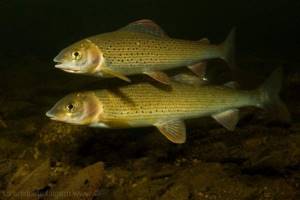
Even if graylings stay in a group, no special relationships are established within the group; graylings simply live not far from each other.
Grayling actively feeds in the morning and in the evenings, when there is no bright sun, but not too dark, at this time the grayling will rise to the surface of the water to search for insects flying to the water. During the day, grayling stays in secluded places, at depth, behind stones or snags.
At night, grayling prefers to be at greater depths. Adult graylings rarely rise to the surface of the water, preferring to spend time close to the bottom.
Most of the time, the grayling stands behind some kind of cover, carefully observing what is happening around. As soon as any living creature appears in his field of vision: a larva or an adult insect that has fallen into the water, they immediately become his prey.
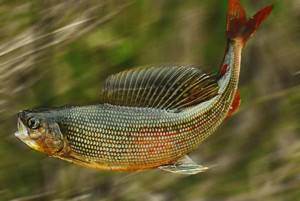
During the year, graylings make two seasonal migrations. In the spring, during spring floods, graylings head upstream to the source of the river and rise into its tributaries. Here they spawn and fatten up. Graylings living in lakes move along the shore of the lake in the spring, in search of tributaries into which they rise for spawning and feeding. The largest graylings, which prefer to stay alone, usually swim further than others in search of a favorable place for spawning.
You might be interested in: Poppers
In the fall, with the onset of cold weather, grayling slide down the river, where they spend the winter in pits at depth. In winter, grayling moves little, but continues to feed. During such seasonal migrations, graylings do not cover significant distances; they usually move no more than a few tens of kilometers.
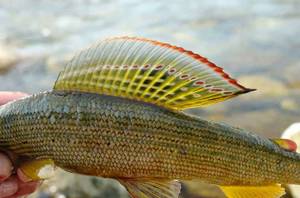
Grayling is a very attentive and cautious fish; it notices everything that happens on the surface of the water and on the shore. If there is any suspicion of danger, the grayling goes into cover or into the depths.
In the evening, you can watch how graylings jump out of the water to a height of up to half a meter, turning over in the air and grabbing insects flying low over the water.
Lures for grayling
When going fishing for grayling, it is important to consider that they are predators. Therefore, you need to choose a bait that is accessible and attractive to him. Also, this fish is shy, and fishing conditions with intense currents create certain obstacles.
Lures can be divided into:
- natural;
- artificial.
From the first group of baits for fishing on the surface, grasshoppers, flies, beetles, dragonflies and horseflies have proven themselves to be excellent. To catch fish in the vast depths, larvae, bloodworms, worms, and maggots are useful. It is good to use minnows (small fish from the carp family).
Among the artificial baits for grayling, the following stand out:
- Rotating spinners (spinners).
With the help of a spinner, the attention of grayling is attracted, and fish are caught using attached natural bait. According to experienced fishermen, even after eating the bait, fishing can be continued with one spoon. For more successful fishing, it is better to use a spoon with dark dots. For fish, they imitate midges or spiders. Popular are large spinners, which are more noticeable in the water. - Wobblers.
Their main advantage is their ability to withstand strong currents; they successfully sink and do not rise to the surface of the water. There is a wide variety of wobblers, which makes it possible to change bait more often in order to catch grayling. Swinging smoothly in the water, they look like a sick fish, thereby attracting grayling. The most suitable bait parameters are 4.5 cm, weighing up to 5 g. Artificial baits can be used repeatedly.
What does grayling eat?
Grayling can be called an omnivorous fish. The basis of the grayling diet consists of various insects that either live in the water (caddisflies, stoneflies, mayflies) or accidentally fall into water (botflies, beetles, grasshoppers).
Graylings are able to jump out of the water and grab an insect that comes too close to the water right in the air. Great speed and high maneuverability allow grayling to quickly and high jump out of the water to grab its prey.
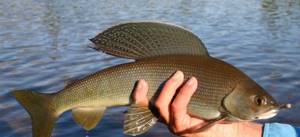
In reservoirs where caddis flies live, grayling feed most actively on them; caddis flies can make up three quarters of its diet.
Grayling can stand for hours behind its shelter, next to the flow of a fast current, patiently waiting for the river itself to bring it something edible.
Graylings of various sizes, both large and small, happily eat small crustaceans, mollusks, worms and various larvae, collecting them from the bottom of the reservoir.
In the spring, during spawning, graylings enjoy feasting on the eggs of other fish. At the hungriest time, when grayling cannot find other food, it satisfies its hunger with algae.
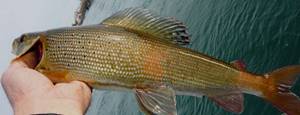
As the age of grayling increases and its size increases, food preferences change. Adult large graylings begin to hunt fry, setting up ambushes near underwater shelters. The largest graylings hunt mice, shrews, voles and other small rodents that, during migration, try to swim across a small river or stream.
Grayling feeds most in the morning, and during the day it picks up insects in the water. Large grayling spends the daytime hours in shelter, among stones, at depth.
Grayling reproduction
Female grayling become capable of reproduction when they reach the age of two years, and males are capable of reproduction only at three years.
With the onset of the breeding season, the appearance of the male grayling changes. The color of the male becomes especially bright and impressive; the large upper fin enlarges in the rear, becoming like a train. Scientists suggest that such a large dorsal fin of the grayling male, with its movements, prevents the milk from being quickly carried away by the current, thereby increasing the efficiency of the fertilization process of eggs.
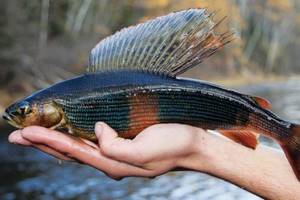
Spawning of grayling begins with warming, when the water warms up to a temperature of 7-8 degrees in the north of the country and to a temperature of 9-11 degrees in the south. This water temperature, as a rule, is established at the end of April - May in the southern regions and only at the beginning of June in the northern regions. The spawning time of Siberian grayling occurs during the period of maximum water level in rivers.
For spawning, grayling chooses shallow sections of the river, where the depth is from 30 to 70 cm. The grayling spawning site should have a moderate current and a sandy or pebble bottom. Graylings living in lakes choose for spawning either shallow places near the shore, or go to spawn in small rivers and streams flowing into this lake.
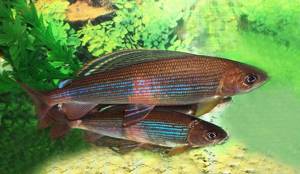
Before laying eggs, the female grayling builds a nest in the form of a depression at the bottom, where she lays her eggs. The female lays eggs with a total number of 3 to 35 thousand eggs, which sink to the bottom. The male sprinkles the laid eggs with sand to protect them from being eaten by other fish. Grayling caviar has an egg diameter of about 3 mm and is light yellow in color. After the eggs are laid, the male and female leave the spawning area and return to their permanent habitats.
After 15-20 days, grayling fry emerge from the eggs. Grayling fry develop very quickly; under good conditions, by the end of the first year they reach a length of 15 cm.
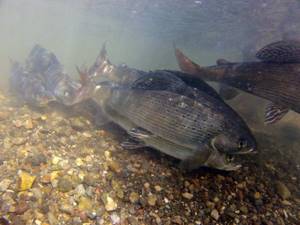
Reproduction of graylings is not very efficient, a significant part of the laid eggs is eaten by other fish, a significant part of the graylings die from predators at the fry stage, out of 10 grayling fry only 2-3 survive.
Enemies of grayling in nature
Until grayling reaches the size of an adult fish, it is hunted by many aquatic land predators. In the water, young grayling are hunted by predatory fish: pike and taimen. Fishing birds such as dippers, kingfishers, terns and gulls also eat young grayling.
Among terrestrial animals, grayling is hunted by large waterfowl mammals, such as minks and otters, and predatory terrestrial mammals: lynxes, arctic foxes and bears.
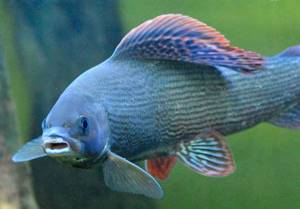
Pike and taimen are the two main enemies of adult grayling in the river. In those reservoirs where there are no pike or taimen, grayling becomes the top of the food chain and can only be threatened by predators living outside the water. First of all, it is a person.
People are the most dangerous to grayling; most adult grayling suffer from them. Grayling is highly valued as a tasty fish, so where it is allowed, it is actively fished, and where it is prohibited to catch it, grayling is exterminated by poachers.
You may be interested in: Daiwa Revros MX reel
Grayling fishing
Grayling is of great interest for sport and recreational fishing, the reason for this is both its excellent taste and the interesting process of catching it. Grayling fishing is practically not carried out on an industrial scale.
Grayling is a very careful and strong fish; it is an honor for any angler to catch it. The process of catching grayling is very exciting and interesting, requiring special skill from the angler. Grayling spends most of its life in a strong current, in constant struggle with which it becomes incredibly strong and resilient. A grayling caught on a hook, even weighing 200-300 grams, stubbornly resists and behaves like a fish of much larger weight. Catching a trophy grayling is a real victory for an angler.
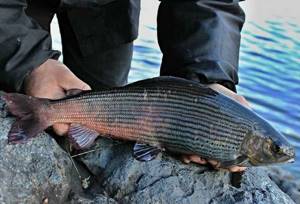
Grayling can be caught in a variety of ways. In summer, grayling is caught by fly fishing, using a float rod, or spinning rod. In winter they catch it with a jig.
Fly fishing for grayling is one of the most interesting and exciting ways to catch this fish. When fly fishing for grayling, special artificial flies that imitate insects are used as bait. The fly must imitate the insect as accurately as possible, otherwise such an attentive and cautious fish as grayling will suspect deception. Grayling has excellent eyesight, so it is impossible to deceive it with a poorly made fly.
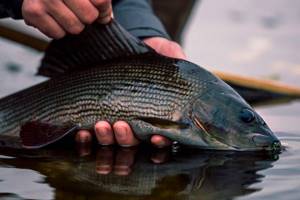
Grayling can be successfully caught using a float rod. The following bait can be used: a worm, whitebait, maggot, bark beetle larva or a piece of fresh fish. Grayling fishing with a float rod is carried out in spring, summer and early autumn. The float when fishing for grayling should be small, light, sensitive and not brightly colored. The fishing line is used with a thickness of no more than 0.15-0.20 mm. Catching grayling with a fishing rod can be successful. Fishing is carried out in pools with whirlpools and holes, with a weak current on the river. When fishing by wire, you can fish in the current, throwing bait into the stream and floating the bait 15-20 meters downstream, if bushes or other anglers do not interfere with this.
When fishing for grayling using a spinning rod, anglers use small spinners, micro-spinners and small wobblers. Grayling fishing with a spinning rod is most often carried out on rifts and other places in the river with a fast current. Spoons when fishing for grayling are most often used numbers No. 1 and No. 2. The use of smaller spoons leads to an increase in bites of very small grayling. Grayling is not a pronounced predator, so it will not chase a fast-swimming spinner or wobbler. Rewinding the fishing line must be done very slowly.
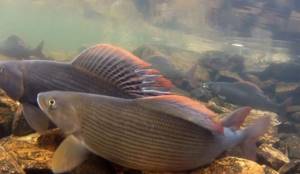
Grayling is caught well not only in summer, but also in winter. When fishing for grayling under the ice, the usual winter fishing gear is used: fishing rods with a nod and a jig. To increase the efficiency of fishing, a worm or piece of fish is attached to a jig hook. When catching grayling with a jig, first lower the jig to the bottom, then lift the jig above the bottom with a sharp swing of the fishing rod, then wait until the jig floats freely to the bottom. Repeat throwing the jig until you feel a grayling bite.
Fishing methods and techniques
Grayling is caught as an object of sport fishing. But residents of the shores of the reservoirs where it lives value it as a tasty and healthy product. The fish meat is light, pinkish in color, with a pleasant taste characteristic of salmon, fatty and nutritious. Everyone has only positive things to say about grayling. It is suitable for different types of dishes; it is also used for future use (pickling, smoking). Grayling caviar is considered valuable.
Only poaching methods of fishing are prohibited. It is recommended to obtain a license to catch grayling, as catch restrictions apply in most areas. Fishing is allowed using float tackle and spinning rods with a spoon.
Read: Nuances of catching grayling in autumn
Read: Master winter fishing for grayling
Tackle
For fly fishing, wooden floats (booms) are used, which can lift up to 100 g of weight. The tackle is secured to the end of the fishing line and allowed to float with the flow; leashes with hooks and bait are attached to the main part of the fishing line, which is pulled by the float.
Sport fishing is carried out using similar float gear: bombard and Tyrolean stick. In them, the leash is attached to the main line after installing a large float that floats with the flow. The bait is found in the bottom layers of water, where fish prey on it.
On the current, other types of equipment (boat, sleigh) are also used. The principle of operation is similar to the previous methods: the leash is delivered to the fishing spot using a floating object.
Long casts can be made using a spinning rod with an inertial reel. Fish are often caught using simple float rods, if it is possible to sail a boat into the deep parts of reservoirs in the summer.
Lures and baits
Objects that grayling prey on are used as bait. These can be lures in the form of insects and flies, to which a lurking predator will react. The best bait is considered to be an earthworm. In the summer, when grayling begins to hunt insects at night, fishing with surface baits and tackle (flies and chub baits) will also be successful. For winter fishing, methods with high-capacity floats are used.
Read: Choosing a spinner for grayling
Read: How to choose a jig for grayling
Grayling in cooking
Grayling meat is quite tasty and tender, with a pleasant smell, reminiscent of trout and salmon in taste. Grayling meat is not red, but light pink.
Grayling meat is a valuable source of protein, has a low fat content, and has a balanced vitamin and mineral composition. Grayling meat has few bones and does not have the smell of mud.
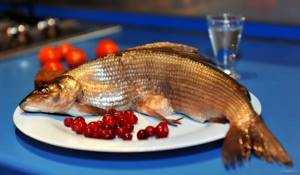
Grayling caviar is a real delicacy. Grayling caviar is especially popular in Siberia and the Far East. Grayling caviar contains essential amino acids, phosphorus, potassium and calcium; it is rich in healthy polyunsaturated fats and easily digestible protein.
You can purchase grayling meat in specialized fish stores or on special Internet sites that deliver food to your home. The price of grayling in stores is usually about 800 rubles/kg.
You can prepare many unusual, original and tasty dishes from grayling. Grayling can be boiled, fried, stewed, salted and baked.
Grayling meat has a delicate, unique taste and aroma, so it is not worth adding a large amount of spices and seasonings to it when cooking.
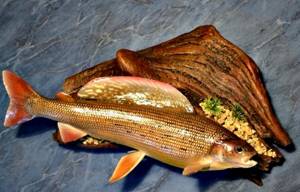
Grayling makes a wonderful, tasty and aromatic fish soup, especially if it is prepared right on the shore, from freshly caught grayling.
A very tasty dish that can be prepared from grayling is rolls. In order to prepare grayling rolls, you must first marinate the grayling fillet in a marinade of sour cream, salt, pepper and garlic. Marinating time is at least an hour. After this, the fillet is rolled into a roll, secured with a toothpick and fried in a frying pan on all sides until an appetizing crust forms.
Fishermen cook grayling immediately after catching it, according to a special recipe. Clean the caught grayling, sprinkle with salt and ground pepper, wrap in three layers of aluminum foil and bake in the hot ashes of the fire for 35-40 minutes. Such grayling, cooked over a fire, smelling fragrantly of smoke, can surprise even a chef from a good restaurant with its taste and aroma.
Properties of grayling
This fish is not only very beautiful, but also quite tasty. Its fillet is distinguished by its tenderness, but at the same time, during processing it does not fall into pieces, but retains its elasticity.
Grayling is often included in diet food because it has a low calorie content. It contains about 90 kcal (per 100 g), and if the fish is not fried or dried, but steamed or boiled, then it can easily replace meat products during the diet.
Unlike many species of fish, grayling does not smell like mud, but like fresh cucumber, which is its distinctive feature.
